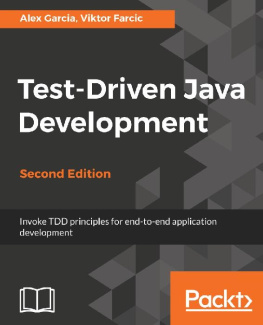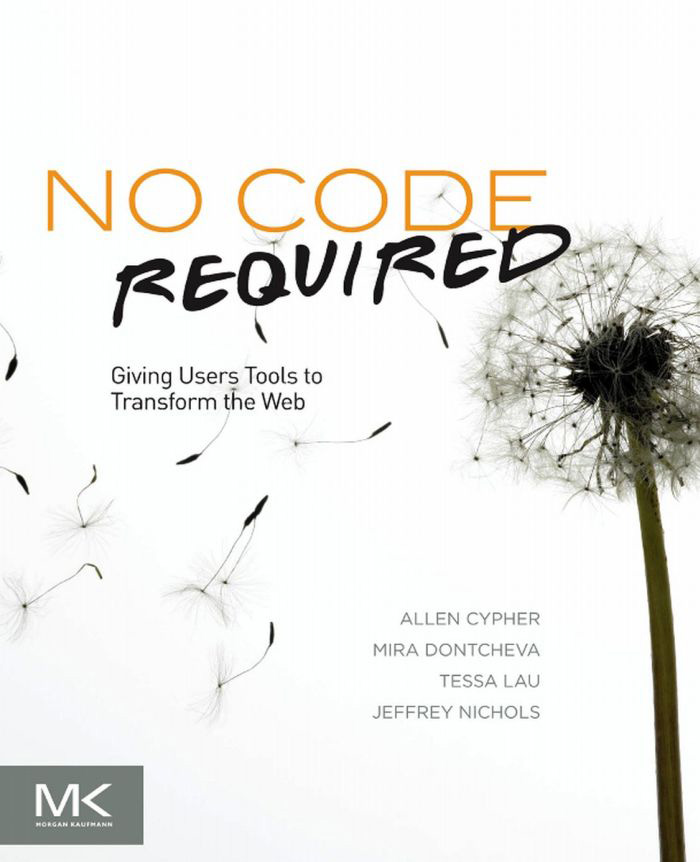No Code Required
No Code Required
Giving Users Tools to Transform the Web
Edited by
Allen Cypher
Mira Dontcheva
Tessa Lau
Jeffrey Nichols

Morgan Kaufmann Publishers is an imprint of Elsevier.
30 Corporate Drive, Suite 400, Burlington, MA 01803, USA
This book is printed on acid-free paper.
2010 Elsevier Inc. All rights reserved.
Material in the work originally appeared in:
For Chapter 3, Proceedings of the 18th Annual ACM Symposium on User Interface Software and Technology ( ACM 2005),
For Chapter 4, Proceedings of the SIGCHI Conference on Human Factors in Computing Systems ( ACM 2006), and CoScripter: automating & sharing how-to knowledge in the enterprise, in Proceedings of the Twenty-Sixth Annual SIGCHI Conference on Human Factors in Computing Systems ( ACM 2008),
For Chapter 5, Proceedings of the 17th Annual ACM Symposium on User Interface Software and Technology ( ACM 2004),
For Chapter 8, Clip, connect, clone: combining application elements to build custom interfaces for information access, by: Jun Fujima, Aran Lunzer, Kasper Hornbaek, Yuzuru Tanaka. ( ACM 2004) and Proceedings of the 17th Annual ACM Symposium on User Interface Software and Technology (UIST 2004),
For Chapter 10, Programming by a sample: leveraging Web sites to program their underlying services, by: Bjrn Hartmann, Leslie Wu, Kevin Collins, Scott R. Klemmer.( ACM 2007) and Proceedings of the 20th Annual ACM Symposium on User interface Software and Technology (UIST 2007),
For Chapter 12, Summarizing personal Web browsing sessions, in Proceedings of the 19th Annual ACM Symposium on User Interface Software and Technology, by: Mira Dontcheva, Steven M. Drucker, G. Wade, David Salesin, and Michael F. Cohen (UIST 2006) and Relations, cards, and search templates: user-guided Web data integration and layout, in Proceedings of the 20th Annual ACM Symposium on User interface Software and Technology by Mira Dontcheva, Steven M. Drucker, David Salesin, and Michael F. Cohen (ACM 2007),
For Chapter 13, Zoetrope: interacting with the ephemeral Web, in Proceedings of the 21st Annual ACM Symposium on User Interface Software and Technology ( ACM 2008),
For Chapter 15, Translating keyword commands into executable code, in Proceedings of the 19th annual ACM Symposium on User Interface Software and Technology ( ACM 2006), Koala: capture, share, automate, personalize business processes on the Web, in Proceedings of the SIGCHI Conference on Human Factors in Computing Systems ( ACM 2007), and Inky: a sloppy command line for the Web with rich visual feedback, in Proceedings of the 21st Annual ACM Symposium on User interface Software and Technology ( ACM 2008),
For Chapter 23, Two studies of opportunistic programming: interleaving Web foraging, learning, and writing code, in Proceedings of the 27th International Conference on Human Factors in Computing Systems ( ACM 2009).
No part of this publication may be reproduced or transmitted in any form or by any means, electronic or mechanical, including photocopying, recording, or any information storage and retrieval system, without permission in writing from the publisher. Details on how to seek permission, further information about the Publishers permissions policies and our arrangements with organizations such as the Copyright Clearance Center and the Copyright Licensing Agency, can be found at our Web site: www.elsevier.com/permissions .
This book and the individual contributions contained in it are protected under copyright by the Publisher (other than as may be noted herein).
Notices
Knowledge and best practice in this field are constantly changing. As new research and experience broaden our understanding, changes in research methods, professional practices, or medical treatment may become necessary.
Practitioners and researchers must always rely on their own experience and knowledge in evaluating and using any information, methods, compounds, or experiments described herein.
In using such information or methods they should be mindful of their own safety and the safety of others, including parties for whom they have a professional responsibility.
To the fullest extent of the law, neither the Publisher nor the authors, contributors, or editors, assume any liability for any injury and/or damage to persons or property as a matter of product liability, negligence or otherwise, or from any use or operation of any methods, products, instructions, or ideas contained in the material herein.
Library of Congress Cataloging-in-Publication Data
Application submitted
British Library Cataloguing-in-Publication Data
A catalogue record for this book is available from the British Library.
ISBN: 978-0-12-381541-5
For information on all Morgan Kaufmann publications,
visit our Web site at www.mkp.com or www.elsevierdirect.com .
Printed in the United States of America
10 11 12 13 5 4 3 2 1

Foreword
There is no question that the Web has become an integral part of modern life for people around the world, connecting us to each other and to seemingly infinite portals of information in real time.
In the era of Web 2.0, barriers to participation have been lowered further and further, and weve seen the birth of myriad new people to connect, learn, share, and collaborate. From blogs to social networks, people are enjoying an increasingly rich online life.
And while the Web has dramatically enriched our lives, we have only just scratched the surface of its potential. Through the rapid expansion and enhancement of the information to which we have access, weve also lost a great deal of freedom and flexibility over it; although most people may not have noticed this yet, as newer is often perceived as better.
Many of the basic abilities we have when consuming and sharing information in the physical world have yet to make the jump to the digital realm. Most Web sites do not yet provide us the ability to integrate our own personal context into the presentation of information and the tools uniquely available to each of us. For instance, before the Web, planning a holiday trip often involved clipping articles and pictures from magazines, collecting brochures, taking tips and hints from friends, writing down details from travel agents, highlighting ratings and reviews of restaurants and hotels from travel books that weve bought or borrowed, noting suggestions on the best seats on an airplane from coworkers, and assembling all this information in one place, often the kitchen table, to finalize travel plans and itinerary.
It was a social experience with a great deal of interaction and discussion, integrated your own personal context (e.g., magazine subscriptions you had, books you owned, previous travel experiences, etc.), and was not overly constrained by the media or medium, from any one source (e.g., there were no technical or legal barriers to mashing up pictures of hotels with ratings from your guide books), as one could easily pull from all sources at once.









